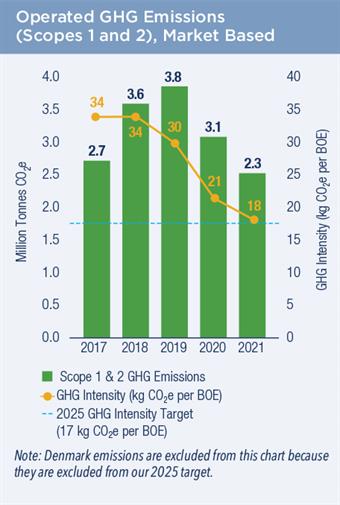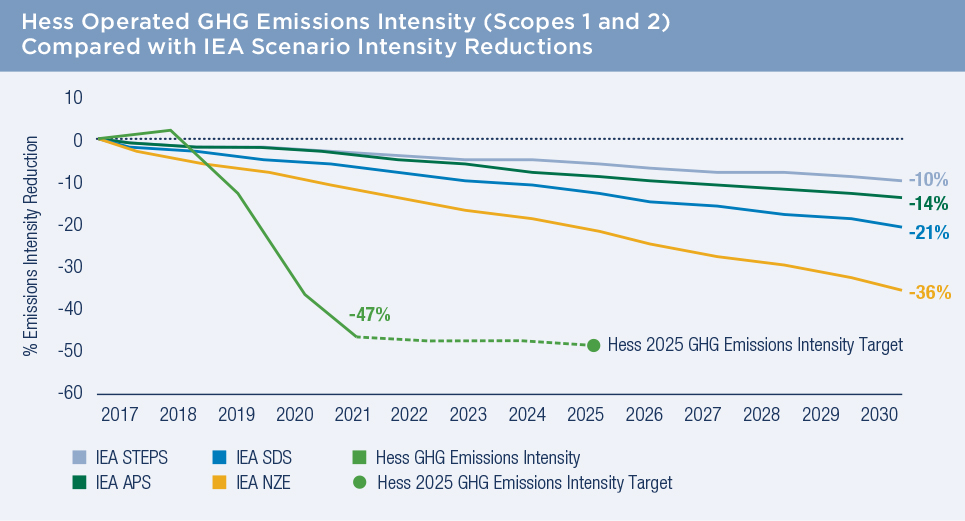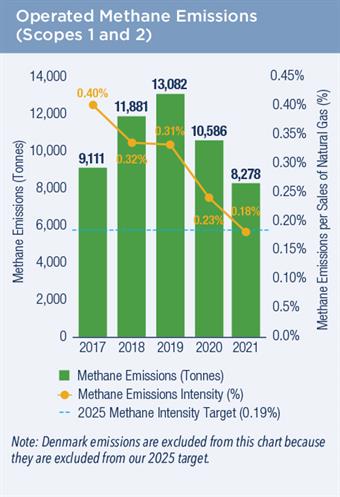Hess’ Climate Change Position
We see climate change as the greatest scientific challenge of the 21st century. We believe climate risks can and should be addressed while at the same time meeting the growing demand for affordable and secure energy, which is essential to ensure a just and orderly energy transition that aligns with the United Nations Sustainable Development Goals. Governments, businesses and civil society must work together on cost effective policies to meet this dual challenge, and we support transparent carbon pricing to encourage the investments needed to accelerate decarbonization across all sectors of the economy while keeping energy affordable. We review the climate positions of our major advocacy organizations on an ongoing basis and, in the event that those positions appear misaligned or become misaligned with Hess’ positions, we will share our viewpoint in an attempt to more closely align their position with ours.
We support the global ambition to achieve net zero emissions by 2050 and the Paris Agreement’s aim to limit global average temperature rise to well below 2°C. Our climate strategy is closely aligned with the recommendations of the Task Force on Climate-Related Financial Disclosures (TCFD), as established by the G20 Financial Stability Board, and its implementation is led by senior members of our leadership team with oversight by our Board of Directors. As part of our commitment to implement a substantive climate strategy, an executive led task force is currently developing a plan for our company to achieve net zero Scope 1 and 2 emissions.
Our Board of Directors is climate change literate, and we periodically bring in subject matter experts to advise our Board on climate and other sustainability issues to be considered in the development of company strategies and policies. Our Board’s Environmental, Health and Safety (EHS) Committee, comprised of independent directors, has a mandate to identify, evaluate, monitor and report to the full Board on climate change issues, trends, risks and opportunities. This committee is actively engaged in overseeing Hess’ sustainability practices and works alongside senior management to evaluate climate change risks and global scenarios in making strategic decisions. For example, the committee has been providing oversight of the executive led task force that is working on the elements of our Low Carbon Transition Framework, including the plan to achieve net zero Scope 1 and 2 emissions. Furthermore, the Board’s Compensation and Management Development Committee has tied executive compensation to advancing the company’s EHS and climate change goals.
Our business planning includes actions we will undertake to continue reducing our carbon footprint consistent with the aim of the Paris Agreement to limit global average temperature rise to well below 2°C. As we work to develop our net zero emissions plan, our Board and senior leadership have set aggressive short and medium term greenhouse gas (GHG) reduction targets. These targets are designed to exceed the carbon intensity reductions by 2030 in the International Energy Agency’s (IEA’s) Sustainable Development Scenario (SDS) and Net Zero Emissions by 2050 Scenario (NZE), which are consistent with the Paris Agreement.
As part of our sustainability commitment, we seek to fund innovation with the potential to mitigate societal emissions, including the Salk Institute’s Harnessing Plants Initiative, which aims to develop plants with larger root systems that are capable of absorbing and storing potentially billions of tons of carbon per year from the atmosphere (see page 53 of our 2021 Sustainability Report to learn more). In 2020, we announced a $12.5 million gift to the Salk Institute, and in 2021, we announced another $3 million gift. We also address 100% of the indirect Scope 2 emissions from our purchased electricity through the purchase of renewable energy certificates (RECs).
We account for the cost of carbon in significant new capital investment decisions. We conduct scenario planning that includes the SDS and NZE to test the resilience of Hess’ portfolio against a range of energy supply and demand, environmental policies and market conditions. According to the IEA, the world is not investing enough to meet its future energy needs, and uncertainties over policies and demand trajectories create a strong risk of a volatile period ahead for energy markets. In 2022, we tested Hess’ portfolio under the IEA’s four scenarios, including the SDS and NZE. We have concluded that Hess can continue to monetize our reserves and deliver strong performance under a wide range of market conditions, including under the aggressive conditions assumed in the SDS. Under the NZE, a normative scenario that reflects a narrow pathway for the global energy sector to achieve net zero carbon dioxide (CO2) emissions by 2050, we could still monetize the majority of our reserves but would expect lower cash margins. We also consider potential physical risks associated with climate change, such as increased severity of storms, drought and flooding, for new projects and existing operations.
Hess’ strategic priorities – to deliver high return resource growth, a low cost of supply and industry leading cash flow growth – are aligned with the energy transition needed to achieve the IEA SDS and position us well for the coming decades.
For a detailed description of our low carbon transition framework, external engagement, governance, investment decisions, risk management, metrics and targets, GHG performance, emissions reduction initiatives and energy use, please refer to our 2021 Sustainability Report.
Metrics and Targets
Following the TCFD’s latest recommendations, our Low Carbon Transition Framework includes short, medium and long term climate related emissions reduction targets. Below is an overview of our medium term climate related emissions reduction targets, but for a detailed description of our metrics and targets for the short, medium and long term, please refer to our 2021 Sustainability Report.
Medium Term Climate Related Emissions Reduction Targets (2025–2031)
 We have established a GHG intensity reduction target for the end of 2025, which we consider to be medium term. Our target is to reduce the GHG emissions intensity of our operated assets to 17 kilogram (kg) carbon dioxide equivalent (CO2e) per barrels of oil equivalent (BOE) by 2025 versus a 2017 baseline of 34 kg CO2e per BOE.
We have established a GHG intensity reduction target for the end of 2025, which we consider to be medium term. Our target is to reduce the GHG emissions intensity of our operated assets to 17 kilogram (kg) carbon dioxide equivalent (CO2e) per barrels of oil equivalent (BOE) by 2025 versus a 2017 baseline of 34 kg CO2e per BOE.
This GHG reduction target utilizes a market based approach to GHG accounting, which allows the use of market based instruments such as RECs to mitigate the environmental impact of Scope 2 GHG emissions. Our location based GHG emissions can be found in the Performance Data table. Through 2021, we have reduced our GHG emissions intensity to 18 kg CO2e per BOE or by approximately 47% compared with our 2017 baseline of 34 kg CO2e per BOE as shown on the chart at right.
We aligned this GHG intensity reduction target with the IEA’s 2021 World Energy Outlook SDS and NZE, as illustrated in the chart below. The 21% carbon intensity reduction between 2017 and 2030 in the SDS is consistent with a well below 2°C ambition, whereas the NZE suggests a 36% reduction during that time frame would be needed to achieve a 1.5°C ambition. These IEA carbon intensity reduction figures are derived using the IEA’s SDS and NZE CO2 emissions divided by their worldwide energy supply estimate in 2030 versus 2017 actuals. Hess’ GHG intensity reduction target is based on our operated Scope 1 and 2 market based GHG emissions normalized by production. The Hess target results in a 50% GHG intensity reduction between 2017 and 2025, which is more aggressive than the IEA SDS’ 21% and NZE’s 36% emissions intensity reductions by 2030. This target is also designed to place us in a leadership position for emissions performance among our peers in the oil and gas industry, based on current publicly available data.

 Hess also set a medium term target to reduce operated methane emissions intensity to 0.19% by 2025, which equates to an over 50% reduction in methane emissions intensity versus our 2017 baseline. As of year end 2021, we have achieved a methane intensity rate of 0.18%, as shown at right, surpassing our 2025 target. We attribute this result to a combination of our continued efforts to reduce methane emissions, which include increasing natural gas capture, reducing flaring, continuing our leak detection and repair program, and replacing and retrofitting the remaining high bleed pneumatic controllers in our North Dakota operations. An additional factor is the updating of our calculation methodology, so that we remain in line with industry standards. While we aim to maintain this performance in support of our year end 2025 target, we are in the process of reevaluating the target to determine if it should be adjusted.
Hess also set a medium term target to reduce operated methane emissions intensity to 0.19% by 2025, which equates to an over 50% reduction in methane emissions intensity versus our 2017 baseline. As of year end 2021, we have achieved a methane intensity rate of 0.18%, as shown at right, surpassing our 2025 target. We attribute this result to a combination of our continued efforts to reduce methane emissions, which include increasing natural gas capture, reducing flaring, continuing our leak detection and repair program, and replacing and retrofitting the remaining high bleed pneumatic controllers in our North Dakota operations. An additional factor is the updating of our calculation methodology, so that we remain in line with industry standards. While we aim to maintain this performance in support of our year end 2025 target, we are in the process of reevaluating the target to determine if it should be adjusted.